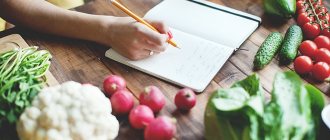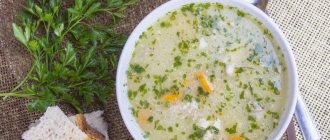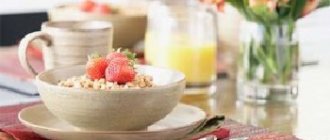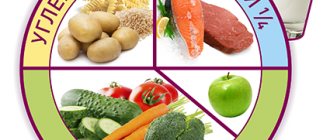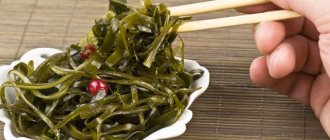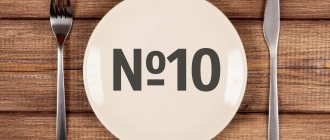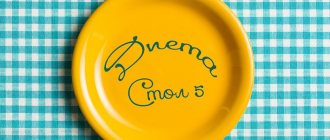11/25/2019 Article
- general characteristics
- Table "Do's and Don'ts"
- Menu for the week
- Diet modifications Diet “Table 4A”
- Diet "Table 4B"
- Diet "Table 4B"
- Diet for children
The “4 table” diet is indicated for acute intestinal diseases and exacerbations during the period of ongoing diarrhea. The goal of the diet is to provide the body with the necessary nutrients without irritating the intestines or causing fermentation in it. “Table 4” refers to strict medical diets; it is prescribed during periods of exacerbation of dyspeptic disorders, chronic intestinal diseases and after operations.
Medicines at affordable prices. A large assortment. Order now!
Antidiarrheal drugs
general characteristics
Goal of the diet:
maximum mechanical and chemical sparing of the intestines, reduction of fermentation processes in it. With the help of this diet, chemical, mechanical and thermal irritations to the intestines are limited in the diet. The diet is indicated for intestinal diseases that occur with diarrhea.
General characteristics:
a diet with a normal amount of protein, limiting fats and carbohydrates to the lower limit of normal. All dishes are boiled or steamed and pureed. Avoid foods and dishes that enhance the processes of fermentation and putrefaction in the intestines; all dishes that stimulate bile secretion, gastric and pancreatic secretion.
Diet:
5–6 times a day, fractional.
Chemical composition and calorie content:
- proteins - 90 g,
- fats - 70 g,
- carbohydrates - 250 g,
- table salt - up to 6-8 g,
- retinol - 2 mg,
- thiamine - 4 mg,
- riboflavin - 4 mg,
- ascorbic acid - 100 mg,
- nicotinic acid - 30 mg,
- calcium - 0.8 g,
- phosphorus - 1.6 g,
- magnesium - 0.5 g,
- iron - 0.015 g,
- free liquid - 1.5 l,
- calories - 2000 kcal.
The diet is physiologically inferior and monotonous, so it is prescribed for 2–5 days, followed by a transfer to the “2 table” or “table 5A” diet.
Find a trusted dietitian in your city and make an appointment online
Consultation with a nutritionist
Nutritionist comments:
For colitis, therapeutic nutrition is a prerequisite for successful treatment.
A properly selected diet and its adherence can quickly get rid of the unpleasant symptoms of the disease. “The right choice of a sanatorium is a significant step towards maintaining and increasing health. “Gorny” is a resort complex that combines the experience and knowledge of Russian and Soviet balneology. The presence of modern medical equipment and innovative installations, the professionalism of the staff and love for their work will serve as the key to extending longevity,” - the head physician of the sanatorium, Alexander Olegovich Karaulov.
Do's and don'ts
Recommended and excluded foods and dishes of the “4 table” diet:
Table “Dos and Don’ts”
| Products and dishes | What is possible | What not to do |
| Bread and flour products | Rusks from 200 g of premium wheat bread, thinly sliced and not crispy. | Other bakery and flour products. |
| Soups | In low-fat, weak meat or fish broth with the addition of mucous decoctions of cereals, semolina, rice, boiled and pureed meat, steamed quenelles and meatballs, egg flakes. | Soups with cereals, vegetables, pasta, milk, strong and fatty broths. |
| Meat and poultry | Lean and lean varieties of beef, veal, chicken, turkey, rabbit. The meat is degreased, fascia and tendons are removed, and in birds, the skin is removed. Steamed or boiled cutlets, quenelles, meatballs. Minced meat with boiled rice instead of bread is passed through a fine grinder 3-4 times. Boiled meat soufflé. | Fatty types and varieties of meat, pieces of meat, sausages and other meat products. |
| Fish | Low-fat types of fresh fish, cut into pieces and chopped (quenelles, meatballs, cutlets), boiled in steam or water. | Fatty species, salted fish, caviar, canned food. |
| Dairy | Freshly prepared calcined or unleavened mashed cottage cheese, steam soufflé. | Whole milk and other dairy products. |
| Eggs | Up to 1-2 pieces per day. Soft-boiled, steamed omelet and in dishes. | Hard-boiled eggs, fried. |
| Cereals | Puree porridges in water or low-fat broth - rice, oatmeal, buckwheat, cereal flour. | Millet, pearl barley, barley, pasta, legumes. |
| Vegetables | Only in the form of decoctions added to soups. | — |
| Snacks | Excluded from the diet. | — |
| Fruits, sweet dishes and sweets | Jelly and jelly from blueberries, dogwoods, bird cherry, quince, pears. Mashed raw apples. Sugar - limited. | Natural fruits and berries, dried fruits, compotes, honey jam and other sweets. |
| Sauces and spices | Only low-fat broth and butter in dishes. | — |
| Beverages | Tea, especially green, black coffee and cocoa with water. Decoctions of rose hips, dried blueberries, black currants, bird cherry, quince. If tolerated, diluted fresh juices from berries and fruits, except grapes, plums, and apricots. | Coffee and cocoa with milk, carbonated and cold drinks. |
| Fats | Only fresh butter, 5 g per serving of the finished dish. | Animal and cooking fats. |
Fully or partially limited products
Diet number 4 for the intestines is based on the exclusion of foods containing fiber. In this regard, vegetables are excluded (can be decoctions or added to soup), bran, whole grain, rye and bran bread with the addition of seeds and cereals, which additionally injure the intestinal mucosa and are poorly digested.
Fresh bread, pastries, pancakes and pancakes cause fermentation and rotting in the intestines and are therefore prohibited. For the same reason, jam, dried fruits, honey, jams and other sweets are not allowed, and sugar is allowed in a limited amount of 50 g per day (in all dishes).
Porridges made from millet, barley, pearl barley, legumes and pasta are coarse and poorly digestible foods that must be excluded during the period of exacerbation of the disease.
Rich fatty broths that enhance intestinal motility, fatty meats, sausages, fatty fish, canned food and salted fish are also prohibited.
Whole milk, sour cream, cream and cheese can cause increased diarrhea . Milk is used only in diluted form when preparing porridges and puddings.
Cocoa and coffee with milk, kvass, carbonated drinks that increase intestinal motility and bloating are unacceptable for these diseases. You cannot eat sauces and marinades, smoked meats, sausages, or ham.
Table of prohibited products
| Proteins, g | Fats, g | Carbohydrates, g | Calories, kcal | |
Vegetables and greens | ||||
| vegetables | 2,5 | 0,3 | 7,0 | 35 |
| vegetables legumes | 9,1 | 1,6 | 27,0 | 168 |
| potato | 2,0 | 0,4 | 18,1 | 80 |
| horseradish | 3,2 | 0,4 | 10,5 | 56 |
Fruits | ||||
| bananas | 1,5 | 0,2 | 21,8 | 95 |
| melon | 0,6 | 0,3 | 7,4 | 33 |
Berries | ||||
| grape | 0,6 | 0,2 | 16,8 | 65 |
Mushrooms | ||||
| mushrooms | 3,5 | 2,0 | 2,5 | 30 |
Nuts and dried fruits | ||||
| dried fruits | 2,3 | 0,6 | 68,2 | 286 |
Cereals and porridges | ||||
| pearl barley | 9,3 | 1,1 | 73,7 | 320 |
| Wheat groats | 11,5 | 1,3 | 62,0 | 316 |
| millet cereal | 11,5 | 3,3 | 69,3 | 348 |
| barley grits | 10,4 | 1,3 | 66,3 | 324 |
Flour and pasta | ||||
| pasta | 10,4 | 1,1 | 69,7 | 337 |
Confectionery | ||||
| jam | 0,3 | 0,2 | 63,0 | 263 |
| jam | 0,3 | 0,1 | 56,0 | 238 |
| candies | 4,3 | 19,8 | 67,5 | 453 |
| cookie | 7,5 | 11,8 | 74,9 | 417 |
Ice cream | ||||
| ice cream | 3,7 | 6,9 | 22,1 | 189 |
Cakes | ||||
| cake | 4,4 | 23,4 | 45,2 | 407 |
Raw materials and seasonings | ||||
| seasonings | 7,0 | 1,9 | 26,0 | 149 |
| mustard | 5,7 | 6,4 | 22,0 | 162 |
Dairy | ||||
| kefir | 3,4 | 2,0 | 4,7 | 51 |
| sour cream | 2,8 | 20,0 | 3,2 | 206 |
Cheeses and cottage cheese | ||||
| cheese | 24,1 | 29,5 | 0,3 | 363 |
Meat products | ||||
| pork | 16,0 | 21,6 | 0,0 | 259 |
| ham | 22,6 | 20,9 | 0,0 | 279 |
Sausages | ||||
| boiled sausage | 13,7 | 22,8 | 0,0 | 260 |
| dry-cured sausage | 24,1 | 38,3 | 1,0 | 455 |
| sausages | 10,1 | 31,6 | 1,9 | 332 |
| sausages | 12,3 | 25,3 | 0,0 | 277 |
Bird | ||||
| duck | 16,5 | 61,2 | 0,0 | 346 |
| goose | 16,1 | 33,3 | 0,0 | 364 |
Fish and seafood | ||||
| dried fish | 17,5 | 4,6 | 0,0 | 139 |
| smoked fish | 26,8 | 9,9 | 0,0 | 196 |
| canned fish | 17,5 | 2,0 | 0,0 | 88 |
Oils and fats | ||||
| vegetable oil | 0,0 | 99,0 | 0,0 | 899 |
| animal fat | 0,0 | 99,7 | 0,0 | 897 |
| cooking fat | 0,0 | 99,7 | 0,0 | 897 |
Non-alcoholic drinks | ||||
| bread kvass | 0,2 | 0,0 | 5,2 | 27 |
Juices and compotes | ||||
| juice | 0,3 | 0,1 | 9,2 | 40 |
| * data is per 100 g of product | ||||
Menu for the week: what you can eat
Options for a weekly menu for each meal according to the “4 table” diet:
1st breakfast options:
- oatmeal with water, soft-boiled egg, tea;
- semolina porridge with water, rosehip decoction, small crackers;
- rice porridge with water, 100 grams of lean pureed cottage cheese, tea;
- semolina porridge with water, steam omelette, tea;
- buckwheat porridge with water, 1 boiled egg, apple broth;
- rice pudding with egg, low-fat cottage cheese, tea;
- steamed buckwheat pudding with cottage cheese, fresh apple puree, green tea.
Options for 2nd breakfast:
- a portion of low-fat cottage cheese;
- applesauce;
- quince jelly;
- dogwood jelly;
- baked apple;
- blueberry decoction, crackers;
- warm blueberry and bird cherry jelly.
Lunch options:
- low-fat meat broth with semolina, rice and steamed chicken quenelles, apple broth;
- rice soup with meatballs, buckwheat porridge, turkey cutlets, quince broth;
- chicken broth with rice and egg flakes, boiled rabbit meatballs, pureed buckwheat, blackcurrant infusion;
- pureed rice, potato and carrot soup, veal meatballs, compote;
- slimy soup with rolled oats and egg flakes, steamed pollock fillet meatballs, tea;
- semolina soup with chicken fillet meatballs, crackers, rosehip infusion;
- potato-semolina soup, boiled rabbit, compote.
Afternoon snack options:
- quince jelly;
- jelly, small cracker;
- warm jelly, a small cracker;
- oatmeal jelly;
- semolina pudding;
- rice water;
- decoction of pears, crackers.
Dinner options:
- potato and zucchini puree, softened boiled hake fillet;
- steam omelette, rice and fish meatballs, green tea;
- pureed rice porridge, steamed lean fish dumplings, tea;
- one poached egg, buckwheat porridge puree, green tea;
- curd and rice casserole, boiled veal soufflé, rosehip infusion;
- curd pudding, soft-boiled egg, oatmeal jelly;
- rice porridge with sugar and a piece of butter, 1 poached egg, green tea.
Options for the night:
- rosehip decoction;
- carrot juice (diluted);
- oatmeal-blueberry jelly;
- apple juice (diluted);
- jelly.
From the above dish options you can create a varied diet for every day.
Diet modifications
In addition to the main diet, there are several variations.
Diet "Table 4A"
Diet “Table 4A” is a diet prescribed for celiac disease, steatorrhea, colitis with the presence of fermentation processes. It is distinguished by a higher amount of protein and calcium contained, the exclusion from the diet of cereal products (bread, cereals, flour products) and products that have a negative effect on liver function.
Diet "Table 4B"
The “Table 4B” diet is prescribed for:
- not a sharp exacerbation of intestinal diseases (colitis, enterocolitis),
- during the period of oncoming recovery in acute form of enterocolitis,
- when accompanied by the listed conditions with diseases of the pancreas, biliary tract, liver and stomach.
The diet is similar to the main diet, but allows the use of:
- dry biscuits, savory buns and pies;
- black caviar, boiled pasta, mild cheeses;
- boiled pureed vegetables: zucchini, zucchini, pumpkin, cauliflower and fresh tomatoes;
- marshmallows, marshmallows, marmalade, jam;
- aromatic herbs: dill and parsley;
- seasonings: bay leaf, vanilla, cinnamon;
- fruits: strawberries, pears, tangerines and apples.
After the “Table 4B” diet, they move on to “Table 4B” or to a regular diet.
Diet "Table 4B"
The “Table 4B” diet is a special diet prescribed during the period of remission and recovery for chronic or acute forms of enterocolitis, infectious and other intestinal diseases. A characteristic feature of the diet: eating food in a non-chopped state, limiting fried foods.
The list of consumed products is expanding: buns with cottage cheese, doctor's or milk sausage, sausages, soaked herring, kefir, fermented baked milk, refined vegetable oil, ripe fruits, beets, tomato juice, compotes.
Diet for children
The “4 table” diet for children is used in case of exacerbation of intestinal diseases in children. It is distinguished by the consumption of large quantities of mineral water, herbal teas, and compotes. Otherwise, the same recommendations apply as for adults.
See also:
- Sanatoriums with gastrointestinal treatment
- Diet “1 table” for gastritis, gastric ulcer and intestinal ulcer
- Diet “2 table” for gastritis
- Diet "3 table" for constipation
- Diet “5 table” for diseases of the liver, biliary tract and gall bladder
- Diet “15 table” for diseases that do not require special therapeutic diets
Save the link:
Varieties
The varieties are Diets 4A , 4B , 4B , which have differences in the set of permitted products and other indications for use. Thus, table 4B is prescribed during a period of improvement or during mild exacerbation of chronic intestinal diseases. Contains more proteins (100-110 g), fats (100 g) and carbohydrates (400-420 g). Has high energy intensity (up to 3000 kcal). The diet remains the same, but the list of permitted foods has been expanded: vermicelli, noodles, carrots, potatoes, cauliflower, zucchini, cream, sour cream, kefir, sweet berries and fruits.
Table 4B is indicated during the period of recovery and transition to normal nutrition. Contains the same amount of proteins, fats (vegetables are already included) and carbohydrates. The list of permitted products has been significantly expanded: buns, pies, cabbage, green peas, beets, doctor's sausage, dairy, ham, oranges, grapes, tangerines, strawberries, watermelon, raspberries, vegetable oil, and the amount of butter has been increased to 15 g per dish.


